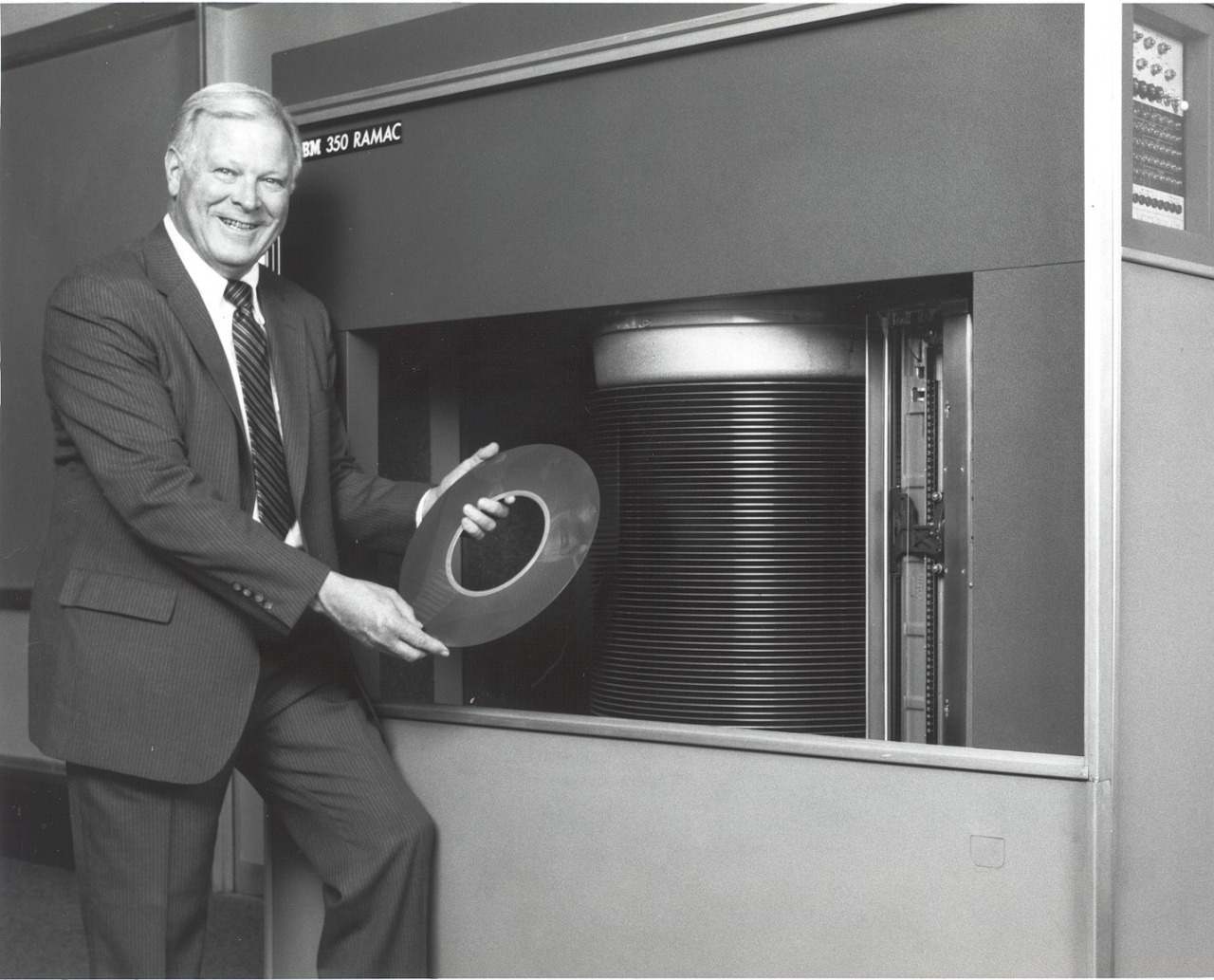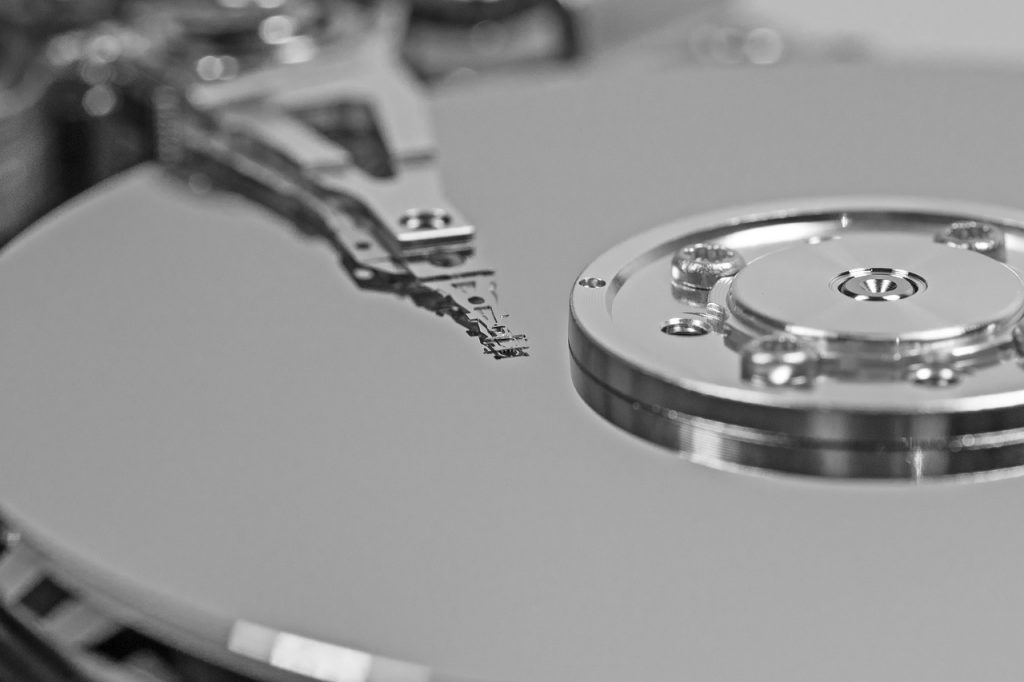Hard disk operation
 |
The mechanical hard drive, a flagship of data storage, remains largely unknown to the general public despite the fact that the vast majority of the world’s digital data is stored on these devices. |
A Bit of History
The first hard drive, the IBM 350, was launched in 1956 and sold over a thousand units in less than five years at a price of $50,000. Adjusted for inflation, that would be over $450,000 today. This beast weighed more than a ton and contained over 50 platters measuring 60 cm in diameter, all accessed by a single read/write head that moved from platter to platter. Its storage capacity was just 5 MB — about the size of a single JPEG photo today.
This storage method has existed for over 60 years! While the basic principle has remained largely the same, miniaturization has significantly reduced physical size and increased storage capacity by more than 800,000 times. In this article, I’ll briefly explain how a mechanical hard drive works.
The Platters
Digital information is stored in the form of 0s and 1s. To record this state, hard drives use magnetism as the storage mechanism. A hard drive has platters, each with two magnetic surfaces (top and bottom). User data is stored on these surfaces as 0s or 1s, depending on the magnetic polarity. These surfaces also store other information, as we’ll see later. Naturally, the greater the density of magnetic bits on a platter, the higher the storage capacity. This is one of the key evolutions since IBM’s first hard drive.
Read/Write Heads
To read or write the orientation of these magnetic bits — determining whether it's a 0 or a 1 — read/write heads (one per surface) are mounted on an arm that moves across the platter surface. All the heads move together, allowing the hard drive to access data on all platters simultaneously.
Platter Rotation
The platters spin at speeds between 5,000 and 15,000 revolutions per minute, depending on the drive. This rotation is critical: as mentioned, it allows the read heads to access the full platter surface since they move along a single axis. The faster the rotation, the more magnetic bits the heads can scan in a given time. Additionally, the friction with the clean, dust-free air inside the drive creates a kind of “wind” over the platters. Thanks to this air cushion, the read heads — which have a slider roughly 1.5 mm in size (think of it as an air cushion vehicle) — actually float above the platters.
The heads must never touch the platters, as doing so would destroy them and permanently damage the magnetic surface. In modern hard drives, the flying height of the heads is about 7 nanometers — approximately 12,000 times thinner than a human hair. The heads themselves are about 10 nanometers in size, the result of extreme miniaturization.
The Electronic Board
The hard drive contains an electronic board that coordinates the movement of the read heads, controls platter rotation, and connects the drive to the computer. This board typically includes a motor controller, a head controller, and a SATA controller. Everything is synchronized by a quartz clock.
Each controller independently manages its specific component (motor, heads, etc.). These controllers have their own firmware, and the hard drive also has its own firmware to determine how and where data is stored on the platter surfaces.
Data Structure
As we’ve seen, platters contain magnetic bits storing your data — but not only that. How can the firmware be sure the data coming from the read heads is what it requested? Thanks to other magnetic bits that “surround” blocks of information bits. Essentially, these bits help the firmware confirm that the heads are at the correct address. Additional bits check whether the data was read without errors. Data is primarily structured into tracks and sectors that form the data’s address. Mechanically, it takes time to position the heads precisely over the target data, which is why HDDs are slower than SSDs that access data electronically. The more fragmented the files, the more the heads need to reposition themselves, increasing access time. That’s why defragmentation can help speed things up by reducing repositioning.
Firmware
Only 1% of the hard drive’s firmware is stored on the electronic board. This tiny portion allows the heads to read the remaining 99%, which is stored in a reserved, hidden area on the platters. Why this setup? Modern firmware is about 100 MB in size. Storing it on the board would drastically raise costs and create reliability issues, such as excessive write operations for the SMART table.
Malfunction
Why does a hard drive fail? There are many possible reasons. For instance, if a read head fails, the firmware becomes inaccessible and the drive won’t initialize — meaning it won’t be “visible” to your computer. The same applies if the firmware is corrupted or the surface it’s stored on is damaged.
The classic “click-click-click” noise doesn’t always mean a head issue. It actually comes from the actuator arm returning to its rest position and trying again — an attempt to recalibrate for another firmware read.
The Future of Hard Drives
Mechanical hard drives still have a bright future. Until 2006, data bits were laid flat on platters, taking up more space. Since then, bits have been aligned vertically, saving space.
To further increase the number of bits per cm², manufacturers must miniaturize them even more. But this brings new problems: during writing, there’s a high risk the write head might flip the polarity of a neighboring bit, which is highly problematic. To solve this, manufacturers are now developing lasers to briefly heat bits before writing. A heated bit requires a less powerful magnetic field to change polarity, reducing the risk of affecting nearby bits.
So the future of hard drives may lie… in lasers.

